 |
 |
|
 |
|
 |
|  |
|  |
|
 |
|
 |
|  |
|  |
|
 |
The perfect really is the enemy of the good. I downloaded POV-Ray in
2003, and quickly learned about the RSOCP tradition, yet it took me
nearly 4 years of careful overconsideration before I made my first PBI
post. In the meantime, I accumulated a folder full of subfolders of
RSOCPs, which I didn't consider perfect enough to post at the time. In
recent years, though, I've been posting occasional renders from these
subfolders.
Here are samples from one series from one of those subfolders, showing
improved metallic textures over the years.
metalballs.jpg was created a month after I downloaded POV-Ray. At that
early date, I didn't yet realize that the 'metallic' keyword could apply
to reflections as well as highlights. metalballs1a.jpg is a
much-improved redux a little over a year later, using my second attempt
at what would eventually become RC3Metal in the Object Collection.
metal_balls1.jpg was an early attempt at blurred reflection, combining
micronormals with my first attempt at what would eventually become
RC3Metal. This was just short of 10 months using POV-Ray.
metalballs2.jpg was created after 11 months of using POV-Ray, using my
second attempt at what would eventually become RC3Metal.
metalballs2a-s1.jpg was more than 2 years after that, using my third
attempt at a set of metal macros. The metals are different than with
metalballs2.jpg, but little progress was made with the textures
themselves. Major progress would not come until 2013, after the
introduction of the 'albedo' keyword in POV-Ray 3.7 and some lessons
from clipka.
metalballs2b.jpg uses RC3Metal and incorporates lessons learned since
2013, mainly relying on micronormals for diffuse reflection, rather than
using a low reflection-to-diffuse ratio as in previous renders. I also
used my latest pre-fab render rig, which has a better implementation of
Fresnel gloss than in the prior images, and has a darker sky for higher
contrast. (The sky still needs major work; the reduction in hue and
saturation of the blue from zenith to horizon is not simulated here.)
To smooth out the microtextures and the highlights on the tile edges, I
rendered the scene at 3x size in EXR, then reduced the image.
metalballs2b-lb.jpg is the same scene with simulated iris diffraction.
The metal textures aren't perfect, and I don't anticipate that they ever
will be; but they're certainly good enough to post.
Post a reply to this message
Attachments:
Download 'metalballs.jpg' (45 KB)
Download 'metalballs1a.jpg' (52 KB)
Download 'metal_balls1.jpg' (21 KB)
Download 'metalballs2.jpg' (147 KB)
Download 'metalballs2a-s1.jpg' (154 KB)
Download 'metalballs2b.jpg' (173 KB)
Download 'metalballs2b-lb.jpg' (177 KB)
Preview of image 'metalballs.jpg'
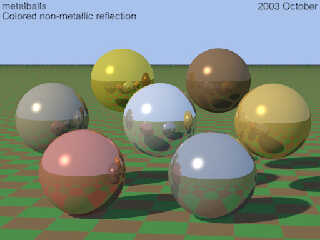
Preview of image 'metalballs1a.jpg'
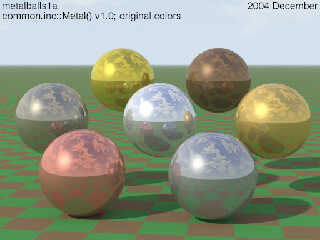
Preview of image 'metal_balls1.jpg'
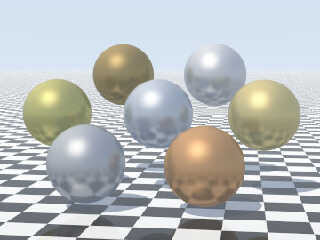
Preview of image 'metalballs2.jpg'
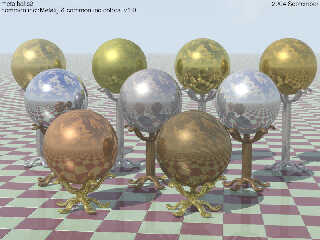
Preview of image 'metalballs2a-s1.jpg'
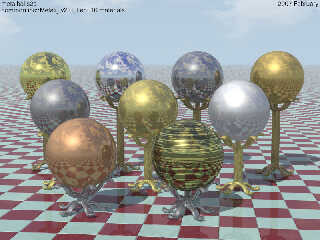
Preview of image 'metalballs2b.jpg'
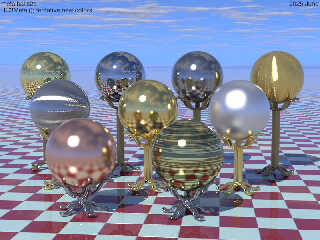
Preview of image 'metalballs2b-lb.jpg'
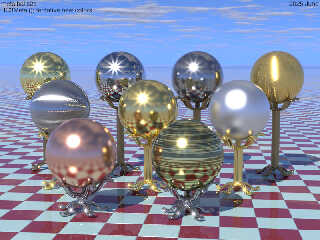
|
 |
|  |
|  |
|
 |
|
 |
|  |
|  |
|
 |
Cousin Ricky <ric### [at] yahoo com> wrote:
> The perfect really is the enemy of the good. I downloaded POV-Ray in
> 2003, and quickly learned about the RSOCP tradition, yet it took me
> nearly 4 years of careful overconsideration before I made my first PBI
> post. In the meantime, I accumulated a folder full of subfolders of
> RSOCPs, which I didn't consider perfect enough to post at the time. In
> recent years, though, I've been posting occasional renders from these
> subfolders.
>
> Here are samples from one series from one of those subfolders, showing
> improved metallic textures over the years.
>
> metalballs.jpg was created a month after I downloaded POV-Ray. At that
> early date, I didn't yet realize that the 'metallic' keyword could apply
> to reflections as well as highlights. metalballs1a.jpg is a
> much-improved redux a little over a year later, using my second attempt
> at what would eventually become RC3Metal in the Object Collection.
>
> metal_balls1.jpg was an early attempt at blurred reflection, combining
> micronormals with my first attempt at what would eventually become
> RC3Metal. This was just short of 10 months using POV-Ray.
>
> metalballs2.jpg was created after 11 months of using POV-Ray, using my
> second attempt at what would eventually become RC3Metal.
>
> metalballs2a-s1.jpg was more than 2 years after that, using my third
> attempt at a set of metal macros. The metals are different than with
> metalballs2.jpg, but little progress was made with the textures
> themselves. Major progress would not come until 2013, after the
> introduction of the 'albedo' keyword in POV-Ray 3.7 and some lessons
> from clipka.
>
> metalballs2b.jpg uses RC3Metal and incorporates lessons learned since
> 2013, mainly relying on micronormals for diffuse reflection, rather than
> using a low reflection-to-diffuse ratio as in previous renders. I also
> used my latest pre-fab render rig, which has a better implementation of
> Fresnel gloss than in the prior images, and has a darker sky for higher
> contrast. (The sky still needs major work; the reduction in hue and
> saturation of the blue from zenith to horizon is not simulated here.)
> To smooth out the microtextures and the highlights on the tile edges, I
> rendered the scene at 3x size in EXR, then reduced the image.
>
> metalballs2b-lb.jpg is the same scene with simulated iris diffraction.
>
> The metal textures aren't perfect, and I don't anticipate that they ever
> will be; but they're certainly good enough to post.
Very cool to see the progression over the years!
Does the note about tentative new colors imply there is an update coming to
RC3Metal soon? I use that a lot...
-- Chris R com> wrote:
> The perfect really is the enemy of the good. I downloaded POV-Ray in
> 2003, and quickly learned about the RSOCP tradition, yet it took me
> nearly 4 years of careful overconsideration before I made my first PBI
> post. In the meantime, I accumulated a folder full of subfolders of
> RSOCPs, which I didn't consider perfect enough to post at the time. In
> recent years, though, I've been posting occasional renders from these
> subfolders.
>
> Here are samples from one series from one of those subfolders, showing
> improved metallic textures over the years.
>
> metalballs.jpg was created a month after I downloaded POV-Ray. At that
> early date, I didn't yet realize that the 'metallic' keyword could apply
> to reflections as well as highlights. metalballs1a.jpg is a
> much-improved redux a little over a year later, using my second attempt
> at what would eventually become RC3Metal in the Object Collection.
>
> metal_balls1.jpg was an early attempt at blurred reflection, combining
> micronormals with my first attempt at what would eventually become
> RC3Metal. This was just short of 10 months using POV-Ray.
>
> metalballs2.jpg was created after 11 months of using POV-Ray, using my
> second attempt at what would eventually become RC3Metal.
>
> metalballs2a-s1.jpg was more than 2 years after that, using my third
> attempt at a set of metal macros. The metals are different than with
> metalballs2.jpg, but little progress was made with the textures
> themselves. Major progress would not come until 2013, after the
> introduction of the 'albedo' keyword in POV-Ray 3.7 and some lessons
> from clipka.
>
> metalballs2b.jpg uses RC3Metal and incorporates lessons learned since
> 2013, mainly relying on micronormals for diffuse reflection, rather than
> using a low reflection-to-diffuse ratio as in previous renders. I also
> used my latest pre-fab render rig, which has a better implementation of
> Fresnel gloss than in the prior images, and has a darker sky for higher
> contrast. (The sky still needs major work; the reduction in hue and
> saturation of the blue from zenith to horizon is not simulated here.)
> To smooth out the microtextures and the highlights on the tile edges, I
> rendered the scene at 3x size in EXR, then reduced the image.
>
> metalballs2b-lb.jpg is the same scene with simulated iris diffraction.
>
> The metal textures aren't perfect, and I don't anticipate that they ever
> will be; but they're certainly good enough to post.
Very cool to see the progression over the years!
Does the note about tentative new colors imply there is an update coming to
RC3Metal soon? I use that a lot...
-- Chris R
Post a reply to this message
|
 |
|  |
|  |
|
 |
|
 |
|  |
|  |
|
 |
On 2025-06-19 08:52 (-4), Chris R wrote:
>
> Does the note about tentative new colors imply there is an update coming to
> RC3Metal soon? I use that a lot...
That's the plan, anyway, except for the "soon" part. The present
RC3Metal colors were eyeballed before I had a full appreciation of how
unreliable our eyeballs are at judging luminance.
I have a plan for measuring colors from digital photographs while taking
the environmental lighting into account, but there are still a couple of
problems. My measurement of an orange brass object looks too yellow,
suggesting there is some flaw in my system. And right now I have no
access to silver, gold, or the many variations of bronze. Wikipedia has
a chart of gold alloy colors, but the chart is not color-calibrated.
Since the user can use any colors they wish, I have not prioritized
measuring new colors. The colors I used for metalballs2b are:
Aluminum rgb <0.905, 0.915, 0.920>
Brass rgb <0.99, 0.78, 0.28>
Golden brass rgb <0.99, 0.70, 0.21>
Yellow brass rgb <0.99, 0.89, 0.38>
Antique brass variations of yellow brass
Bronze RC3M_C_BRONZE
Chrome rgb <0.550, 0.555, 0.555>
Copper rgb <0.99, 0.54, 0.38>
Stainless steel rgb 0.425
I have also been using rgb <0.99, 0.76, 0.33> and rgb <0.99, 0.92, 0.35>
for golds, based on SpectralRender, but I have no idea how they match up
to actual 24K gold and its alloys.
These colors are intended for assumed_gamma 1. If you use some other
assumed_gamma, these colors are equivalent:
Aluminum srgb <0.9570, 0.9617, 0.9640>
Brass srgb <0.9956, 0.8962, 0.5657>
Golden brass srgb <0.9956, 0.8543, 0.4956>
Yellow brass srgb <0.9956, 0.9500, 0.6500>
Bronze srgb <0.6343, 0.5469, 0.3811>
Chrome srgb <0.7674, 0.7705, 0.7705>
Copper srgb <0.9956, 0.7611, 0.6500>
Stainless steel srgb <0.6836, 0.6836, 0.6836>
Gold srgb <0.9956, 0.8860, 0.6097>
Light gold srgb <0.9956, 0.9640, 0.6262>
The latest RC3Metal is 2.1-beta.1 on GitHub; it has a new macro for
adjusting the roughness of the specular highlights, but the suggested
colors are unchanged.
Post a reply to this message
|
 |
|  |
|  |
|
 |
|
 |
|  |
|  |
|
 |
Cousin Ricky <ric### [at] yahoo com> wrote:
> The metal textures aren't perfect, and I don't anticipate that they ever
> will be; but they're certainly good enough to post.
I like it.
It's always amazing to look back over the progress we've all made, and how old
scenes have benefited from the years of learning and experience.
Those spheres are looking really nice.
I'm always looking at things around me with new eyes.
Undulations, imperfections, IOR, caustics, radiosity, "metallic" reflections,
micronormals, semi-random patterns, regular but perturbed patterns, perspective
and lens distortion, chromatic aberration, . . . the list is endless.
Your renders are always good enough to post.
I think a lot of people learn from them, even if they don't reply (right away ;)
)
- BE com> wrote:
> The metal textures aren't perfect, and I don't anticipate that they ever
> will be; but they're certainly good enough to post.
I like it.
It's always amazing to look back over the progress we've all made, and how old
scenes have benefited from the years of learning and experience.
Those spheres are looking really nice.
I'm always looking at things around me with new eyes.
Undulations, imperfections, IOR, caustics, radiosity, "metallic" reflections,
micronormals, semi-random patterns, regular but perturbed patterns, perspective
and lens distortion, chromatic aberration, . . . the list is endless.
Your renders are always good enough to post.
I think a lot of people learn from them, even if they don't reply (right away ;)
)
- BE
Post a reply to this message
|
 |
|  |
|  |
|
 |
|
 |
|  |
|
 |




![]()